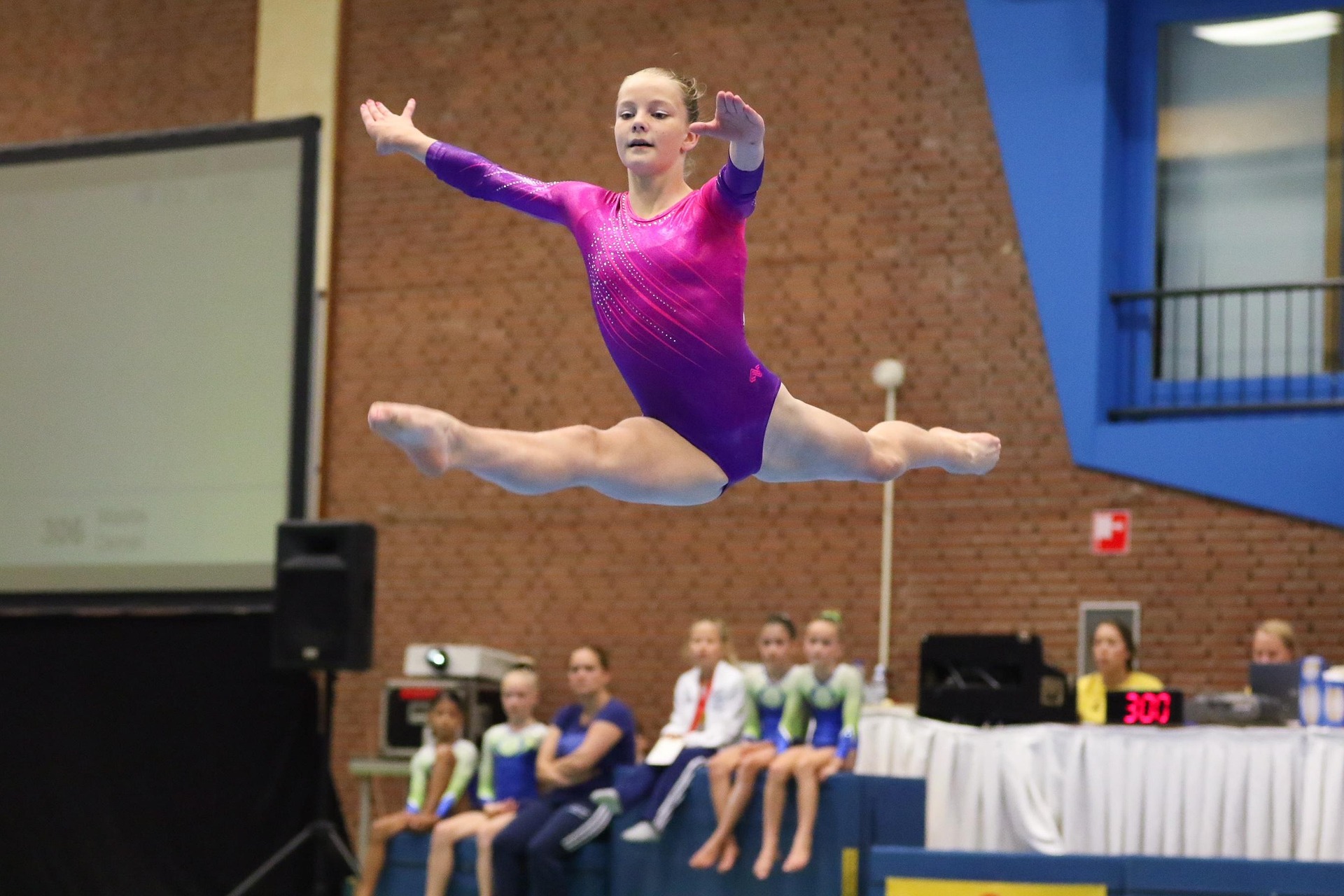Rhythmic Gymnastics: The Fusion of Art and Athleticism
In the realm of competitive sports, few disciplines blend artistry and physical prowess as seamlessly as rhythmic gymnastics. This captivating sport, often overshadowed by its more widely recognized cousin artistic gymnastics, has been quietly evolving into a mesmerizing spectacle of grace, flexibility, and precision. Rhythmic gymnastics challenges athletes to manipulate apparatus such as ribbons, hoops, and balls while executing complex choreography, pushing the boundaries of human movement and creativity.

The Evolution of Rhythmic Gymnastics
Rhythmic gymnastics has undergone a remarkable transformation since its inception. In the early 1900s, Émile Jaques-Dalcroze, a Swiss music teacher, developed a system of movement called eurhythmics, which laid the foundation for what would become rhythmic gymnastics. This system emphasized the connection between music and bodily movement, a principle that remains at the core of the sport today.
As the discipline gained popularity, particularly in Eastern Europe, it began to incorporate elements from ballet and modern dance. The Soviet Union played a crucial role in the sport’s development, with coaches and athletes pushing the boundaries of what was possible with apparatus manipulation and body movements. By the 1960s, rhythmic gymnastics had established itself as a distinct sport, with its first World Championships held in Budapest in 1963.
The sport’s Olympic debut came in 1984 at the Los Angeles Games, marking a significant milestone in its global recognition. Since then, rhythmic gymnastics has continued to evolve, with rule changes and technical advancements leading to increasingly complex and spectacular routines.
The Technical Mastery of Apparatus
At the heart of rhythmic gymnastics lies the masterful manipulation of apparatus. Athletes must demonstrate exceptional control and creativity with five different tools: the hoop, ball, ribbon, clubs, and rope. Each apparatus presents unique challenges and opportunities for artistic expression.
The hoop, typically made of plastic and measuring 80-90 centimeters in diameter, requires gymnasts to perform throws, rolls, and rotations around the body. The ball, usually made of rubber and 18-20 centimeters in diameter, demands precise handling and balancing techniques. The ribbon, perhaps the most visually striking apparatus, consists of a 6-meter satin ribbon attached to a 50-60 centimeter stick, allowing for sweeping patterns and intricate figures in the air.
Clubs, resembling bowling pins and measuring 40-50 centimeters in length, are used in pairs to create mesmerizing juggling sequences and rhythmic tapping. The rope, while no longer used in individual competition at the highest levels, remains an essential training tool and is still featured in group routines.
Mastery of these apparatus requires years of dedicated practice. Gymnasts must develop not only the physical skills to manipulate the tools but also the artistry to incorporate them seamlessly into their choreography, creating a fluid and captivating performance.
The Physical Demands of Rhythmic Gymnastics
Behind the graceful movements and dazzling routines lies an intense physical regimen that pushes athletes to their limits. Rhythmic gymnasts must possess an extraordinary combination of flexibility, strength, balance, and coordination. The sport demands a level of body control that few other disciplines can match.
Flexibility is paramount in rhythmic gymnastics. Athletes must be able to perform extreme ranges of motion, including splits, backbends, and contortions that seem to defy human anatomy. This flexibility is not innate but developed through years of consistent stretching and conditioning.
Core strength forms the foundation of every movement in rhythmic gymnastics. A strong core allows gymnasts to maintain proper form during complex maneuvers and provides the stability necessary for apparatus control. Additionally, upper body strength is crucial for executing throws and catches, while leg strength enables powerful leaps and precise landings.
Balance and coordination are refined through countless hours of practice. Gymnasts must be able to perform intricate footwork and body movements while simultaneously manipulating their apparatus, often while spinning or in mid-air. This requires an exceptional level of proprioception and spatial awareness.
The cardiovascular demands of the sport should not be underestimated. A typical routine lasts between 75 and 90 seconds, during which the gymnast must maintain high-intensity movement without showing signs of fatigue. This necessitates a robust aerobic capacity and muscular endurance.
The Artistic Elements: Music, Choreography, and Expression
While the physical aspects of rhythmic gymnastics are undeniably impressive, it is the artistic elements that truly set the sport apart. The fusion of music, choreography, and personal expression creates a unique form of athletic artistry that captivates audiences and challenges athletes to become not just competitors, but performers.
Music plays a central role in rhythmic gymnastics, serving as both inspiration and guide for the routine. Unlike in artistic gymnastics, where music is primarily background accompaniment, in rhythmic gymnastics, the choreography is intimately tied to the musical composition. Gymnasts and their coaches carefully select pieces that complement their style and showcase their strengths.
The choreography in rhythmic gymnastics is a complex interplay of body movements, apparatus manipulation, and artistic expression. Routines must demonstrate a variety of elements, including jumps, leaps, pivots, and balances, all while maintaining fluid control of the apparatus. The challenge lies in seamlessly blending these technical elements with more expressive movements that interpret the music and convey emotion to the audience.
Personal expression is a crucial component of a successful routine. Gymnasts are encouraged to develop their unique style, infusing their performances with personality and charisma. This aspect of the sport allows athletes to transcend mere technical execution and become true artists, connecting with the audience on an emotional level.
Judging and Scoring: The Balance of Technicality and Artistry
The scoring system in rhythmic gymnastics reflects the dual nature of the sport, evaluating both technical proficiency and artistic merit. Understanding this system provides insight into the complexities and nuances that define excellence in the discipline.
The current scoring system, implemented by the International Gymnastics Federation (FIG), is divided into two main components: Difficulty (D) and Execution (E). The Difficulty score assesses the technical content of the routine, including the complexity of apparatus handling, body movements, and dance steps. Gymnasts receive points for each element they successfully perform, with more challenging skills earning higher values.
The Execution score, starting from a base of 10 points, evaluates the quality of the performance. Judges deduct points for technical errors, such as dropping the apparatus or losing balance, as well as artistic shortcomings, including lack of expression or poor synchronization with the music. The goal is to perform a highly difficult routine with flawless execution and artistic interpretation.
In addition to these main components, judges also consider the overall artistic impression of the routine. This includes factors such as the originality of the choreography, the appropriateness of the music choice, and the gymnast’s ability to engage the audience and convey emotion through their performance.
The complexity of this scoring system highlights the multifaceted nature of rhythmic gymnastics. Athletes must strike a delicate balance between pushing the boundaries of difficulty and maintaining clean, expressive execution. This challenge drives the continuous evolution of the sport, as gymnasts and coaches constantly seek new ways to innovate within the framework of the rules.
Training Methodologies and Career Progression
The path to excellence in rhythmic gymnastics is long and demanding, requiring a comprehensive approach to training that begins at a young age. Most elite gymnasts start their training between the ages of 4 and 6, developing basic flexibility, coordination, and ballet techniques before progressing to apparatus work.
As athletes advance, their training regimens become increasingly intense and specialized. A typical day for an elite rhythmic gymnast might include several hours of physical conditioning, flexibility training, apparatus handling practice, and choreography rehearsal. Cross-training with disciplines such as ballet, contemporary dance, and Pilates is common, helping gymnasts develop the diverse skill set required for success.
Mental preparation is equally important in rhythmic gymnastics. Athletes must cultivate focus, resilience, and performance skills to excel under the pressure of competition. Many gymnasts work with sports psychologists to develop mental strategies for managing anxiety, maintaining concentration, and performing consistently.
The career progression in rhythmic gymnastics typically follows a structured path. Young gymnasts start in local and regional competitions, gradually working their way up to national and international events. The pinnacle of the sport is Olympic competition, where individual all-around and group events are contested.
However, the intense physical demands of rhythmic gymnastics often lead to relatively short competitive careers at the elite level. Many gymnasts reach their peak in their late teens or early twenties, with retirement typically coming before the age of 25. This reality underscores the importance of holistic athlete development, including education and career planning beyond competitive gymnastics.
The Global Landscape of Rhythmic Gymnastics
While rhythmic gymnastics has its roots in Europe, it has grown into a truly global sport with passionate followings and strong competitive programs in countries around the world. However, the international landscape of the sport remains characterized by certain dominant forces and emerging challengers.
Eastern European countries, particularly Russia, Belarus, and Ukraine, have long been powerhouses in rhythmic gymnastics. The strong ballet traditions and systematic training programs in these nations have produced generations of world-class gymnasts. Russian athletes, in particular, have dominated Olympic and World Championship podiums for decades.
However, the global landscape is evolving. Countries like Italy, Israel, and Bulgaria have made significant strides in recent years, challenging the traditional hierarchy. Asian nations, notably China and Japan, have also been investing heavily in their rhythmic gymnastics programs, producing increasingly competitive athletes on the world stage.
The United States, while a gymnastics powerhouse in artistic disciplines, has historically lagged in rhythmic gymnastics. However, growing interest and improved training programs are beginning to yield results, with American gymnasts making notable progress in international competitions.
This increasing global competitiveness is driving innovation in training methods, choreography, and apparatus handling techniques. As more countries develop strong rhythmic gymnastics programs, the sport benefits from a diversity of styles and approaches, enriching the artistic tapestry of performances seen in international competitions.
Challenges and Controversies in Rhythmic Gymnastics
Like many elite sports, rhythmic gymnastics faces its share of challenges and controversies. Addressing these issues is crucial for the continued growth and integrity of the discipline.
One of the most pressing concerns is the physical and psychological toll on young athletes. The demands of the sport, combined with the pressure to maintain an aesthetically pleasing physique, can lead to issues such as eating disorders, overtraining injuries, and burnout. The gymnastics community has been working to implement safeguards and promote healthier training environments, but challenges remain.
Judging controversies have also plagued the sport. The subjective nature of artistic evaluation, combined with the complexity of the scoring system, sometimes leads to disputes over results. Efforts to improve judging consistency and transparency are ongoing, including the use of video review and more detailed scoring breakdowns.
The issue of diversity and inclusion in rhythmic gymnastics has gained increasing attention. Historically, the sport has been dominated by a particular body type and aesthetic. There are growing calls within the gymnastics community to celebrate a wider range of body types and cultural expressions in rhythmic gymnastics, making the sport more inclusive and representative of global diversity.
Equipment standardization is another area of ongoing discussion. As athletes push the boundaries of what is possible with apparatus manipulation, questions arise about the safety and fairness of certain modifications to equipment. Striking a balance between innovation and maintaining a level playing field is an ongoing challenge for the sport’s governing bodies.
The Future of Rhythmic Gymnastics
As rhythmic gymnastics continues to evolve, several trends and potential developments are shaping its future. Technology is playing an increasingly important role, both in training and competition. Motion capture systems and biomechanical analysis are helping coaches and athletes refine techniques and prevent injuries. In competition, video replay and digital scoring systems are improving judging accuracy and transparency.
There is a growing emphasis on storytelling and thematic performances in elite routines. Gymnasts are increasingly crafting routines that tell a cohesive story or express a particular theme, elevating the artistic aspect of the sport to new heights. This trend is likely to continue, pushing the boundaries of what is considered possible in terms of artistic expression within the framework of competitive gymnastics.
The integration of new music styles and cultural influences is also expanding the artistic palette of rhythmic gymnastics. While classical and instrumental music remains popular, more gymnasts are experimenting with contemporary genres and culturally diverse musical selections, bringing fresh energy and diversity to performances.
Efforts to broaden the appeal of rhythmic gymnastics are likely to continue. This may include modifications to competition formats to make the sport more televisual and spectator-friendly, as well as grassroots initiatives to introduce more people to the discipline at a recreational level.
As the sport grows and evolves, maintaining the delicate balance between athletic prowess and artistic expression will be crucial. The unique charm of rhythmic gymnastics lies in its ability to seamlessly blend these elements, creating performances that are both physically impressive and emotionally moving.
Conclusion: The Enduring Appeal of Rhythmic Gymnastics
Rhythmic gymnastics stands as a testament to the incredible potential of the human body and spirit. It is a discipline that demands not only physical perfection but also creativity, expressiveness, and a deep connection to music and movement. The sport challenges athletes to be both supreme athletes and captivating artists, pushing the boundaries of what is possible in human performance.
As rhythmic gymnastics continues to evolve, it offers a unique window into the intersection of sport, art, and culture. The dedication and artistry displayed by rhythmic gymnasts inspire audiences worldwide, showcasing the beauty that can emerge when athletic excellence meets creative expression.
Whether viewed as a competitive sport, an art form, or a celebration of human movement, rhythmic gymnastics remains a captivating and evolving discipline. Its ability to continuously reinvent itself while honoring its rich traditions ensures that it will continue to mesmerize and inspire for generations to come. As we look to the future of sport and physical culture, rhythmic gymnastics stands as a shining example of the heights that can be achieved when we push the limits of both body and imagination.





